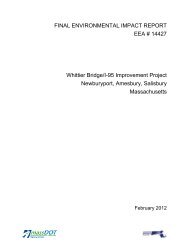Herbicide Alternatives Research - Executive Office of Transportation
Herbicide Alternatives Research - Executive Office of Transportation
Herbicide Alternatives Research - Executive Office of Transportation
You also want an ePaper? Increase the reach of your titles
YUMPU automatically turns print PDFs into web optimized ePapers that Google loves.
2.3.1 Integrated Management for Roadside Weed Control<br />
Integrated Vegetation Management (IVM). Roadside vegetation management takes many<br />
approaches including traditional application <strong>of</strong> nonselective and selective herbicides, intensive<br />
mowing, brushing, and hand weeding as well as a preventive maintenance approach commonly<br />
labeled as Integrated Vegetation Management (IVM) or Integrated Roadside Vegetation<br />
Management (IRVM). The approach <strong>of</strong> IVM is similar to that <strong>of</strong> Integrated Pest Management<br />
(IPM), a systematic strategy in pest management that has been adapted widely in production<br />
agriculture and in landscape management (Buhler, 2002; Cook, 2000; Elmore, 1996; Jacobsen,<br />
1997; Prokopy, 1994).<br />
In theory, IVM employs a variety <strong>of</strong> approaches in the management <strong>of</strong> roadside vegetation. As<br />
with IPM, IVM methods include cultural, mechanical, biological, and chemical strategies,<br />
including chemical herbicides.<br />
With respect to roadside vegetation management, examples <strong>of</strong> cultural practices include the<br />
promotion <strong>of</strong> desirable plant species to reduce opportunities for weed species to become<br />
established or grow with vigor and mowing high (4 to 6 inches) to clip weeds, while maintaining<br />
desirable species below the mowing level. Mechanical practices include mowing, weeding,<br />
grubbing, and cutting <strong>of</strong> woody species. Biological approaches include release <strong>of</strong> predatory<br />
species and the planting <strong>of</strong> dense-growing ground covers to exclude weeds. Chemical methods<br />
may include application <strong>of</strong> growth regulators and conventional or alternative herbicides.<br />
Henderson (2000) reported considerable variation in knowledge <strong>of</strong>, definition <strong>of</strong>, and practice <strong>of</strong><br />
IVM among state DOTs. A detailed description <strong>of</strong> the principles, procedures, and practical<br />
application <strong>of</strong> IVM are presented in Integrated Vegetation Management for Roadsides (Daar and<br />
King, 1997) for the Washington State DOT and in Best Practices Handbook on Roadside<br />
Vegetation Management (Johnson, 2000) for Minnesota. Some <strong>of</strong> the topics discussed include:<br />
definitions <strong>of</strong> IVM; integrating IVM into the maintenance programs; monitoring the programs;<br />
selecting; applying; and evaluating treatments, education and outreach.<br />
Roadside Vegetation Management Zones. <strong>Research</strong>ers at The Pennsylvania State University<br />
(Gover et al., 2000) describe the concept <strong>of</strong> roadside Vegetation Management Zones. Similar<br />
vegetation zones have been described by other investigators (Daar and King, 1997; Johnson,<br />
2000; Nowak 2004). Each zone is defined on the basis <strong>of</strong> target vegetation and the intensity <strong>of</strong><br />
maintenance needed. The zones as described by Gover et al. (2000) are primarily for limitedaccess<br />
highways but also relate to maintenance along free-access roadways. Most states use a<br />
similar concept although the details vary. The management zones as defined by Gover et al.<br />
(2000) are:<br />
Non-Selective Zone (Zone 1). This area is immediately adjacent to a roadway and needs to be<br />
kept essentially free <strong>of</strong> vegetation to facilitate flow <strong>of</strong> water <strong>of</strong>f the roadway and to maintain<br />
visibility. This zone includes the area beneath guard rails.<br />
Safety Clear Zone (Zone 2). This zone may extend up to a distance <strong>of</strong> 30 feet from the road edge.<br />
Typically, this area is seeded to grasses or other low growing vegetation and is kept free <strong>of</strong><br />
16
















